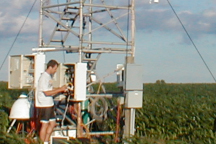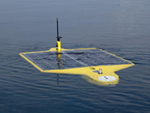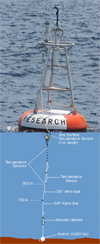
skip to content
Providing a
Research
Foundation
for
NOAA in:
 Monitoring Our Climate: The Value of Atmospheric Reference Observations
Monitoring Our Climate: The Value of Atmospheric Reference Observations
The Air Resources Laboratory participates in several national and international climate reference observing networks, providing leadership in establishing networks, designing, operating and maintaining observing sites, and analysis of the data.
How do we know that our climate has changed? How will we know how and why climate will have changed in the coming years, decades, and even centuries? These are two of the many climate-related questions scientists in NOAA have dedicated themselves to addressing. Such information is essential, as the United States and the world decide how to address climate change.

 Solar powered autonomous underwater vehicle..
Solar powered autonomous underwater vehicle..Harbor Branch Consortium Becomes NOAA’s Newest Cooperative Institute -- NOAA announced the award of a new cooperative institute to focus on ocean exploration, research, and technology development for the U.S. East Coast. The institute is a consortium to be led by and headquartered at the Harbor Branch Oceanographic Institute at Florida Atlantic University in Fort Pierce, Fla. The University of North Carolina Wilmington will be the co-managing partner and limited partners are SRI International, St. Petersburg, Fla., and the University of Miami.

Indian Ocean Buoy.
Network of Research Buoys in Indian Ocean to Improve Monsoon Prediction -- A new array of moored buoys in the Indian Ocean will provide critical climate and ocean data to help scientists predict the dramatic variations between seasonal monsoon rains and droughts.
“The data from these buoys will provide us with much-needed information to advance our understanding of the oceanic and atmospheric processes that govern the monsoons,” said Michael McPhaden, an oceanographer at NOAA’s Pacific Marine Environmental Laboratory in Seattle. “We want to improve computer models for seasonal forecasting to benefit farming communities and other weather-sensitive sectors of society.”
NOAA Brings Great Lakes to Google Ocean -- NOAA is helping Americans peer beneath the surfaces of the five Great Lakes by providing Google Earth with data that now includes detailed three-dimensional mapping of Lakes Huron, Ontario, Erie, Superior and Michigan.
Greenhouse Gases Continue to Climb Despite Economic Slump
Carbon Dioxide, Methane Increased in 2008 -- Two of the most important climate change gases increased last year, according to a preliminary analysis for NOAA’s annual greenhouse gas index, which tracks data from 60 sites around the world.
National Tornado Experiment to Begin in May -- A collaborative nationwide project exploring the origins, structure and evolution of tornadoes will occur from May 10 through June 13 in the central United States. The project, Verification of Origin of Rotation in Tornadoes EXperiment2 (VORTEX2 or V2), is the largest and most ambitious attempt to study tornadoes in history and will involve more than 50 scientists and 40 research vehicles, including 10 mobile radars.
Maintaining an active constituent relations program ensures that OAR and NOAA leadership communicate effectively and often with their most important customers. The recent Commerce and Transportation Roundtable solicited input to ensure NOAA’s research priorities support the Nation's commerce and transportation activities by providing information for safe, efficient, and environmentally sound transportation.
Learn
about
NOAA RESEARCH
-- from
A to Z!
G is for GFDL – The Geophysical Fluid Dynamics Laboratory conducts leading-edge research on many topics of great practical value, including weather and hurricane forecasts, El Niño prediction, stratospheric ozone depletion, and global warming. [more]
NOAA Research Matters PODCASTS
 Chris
Meinig, Director of Engineering, NOAA Pacific Marine Environmental
Laboratory
Chris
Meinig, Director of Engineering, NOAA Pacific Marine Environmental
Laboratory
research.noaa.gov
Updated 4/23/2009
U.S.
Department of Commerce
National Oceanic
and Atmospheric Administration
CONTACT US | PRIVACY
POLICY | DISCLAIMER
Freedom
of Information Act (FOIA) | Information
Quality | USA.gov
